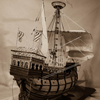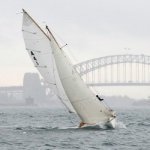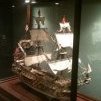-
Posts
832 -
Joined
-
Last visited
Reputation Activity
-
 woodrat got a reaction from Mike Y in Le Gros Ventre 1767 by woodrat - Scale 1:48 - POF - French exploration vessel
woodrat got a reaction from Mike Y in Le Gros Ventre 1767 by woodrat - Scale 1:48 - POF - French exploration vessel
The double main wales have been affixed with pins and will be treenailed later. The sheer has been cut. The next step will be adding the keelson.
Cheerio
Dick
-
 woodrat got a reaction from Mark Pearse in Le Gros Ventre 1767 by woodrat - Scale 1:48 - POF - French exploration vessel
woodrat got a reaction from Mark Pearse in Le Gros Ventre 1767 by woodrat - Scale 1:48 - POF - French exploration vessel
Thanks, Steven. I was feeling a mite guilty because the thing sat in its building frame for years glaring balefully at me from the back of the workshop. It's now starting to look like a ship and hopefully a happy one!
Here is the view from below out of the frame
It was necessaery to measure, remeasure and re-remeasure the position of the deck clamp as this is the most vital for all other measurements. Also the deck must end up horizontal. fortunately with the building frame holding the hull strongly in a vertical position, it was possible to measure directly off the plan
and transfer the measurement directly to the frames
The main deck clamp ready for insertion
The main deck clamp fixed in position and horizontality checked
The main deck clamp installed
Cheers
dick
-
 woodrat got a reaction from Landlubber Mike in Le Gros Ventre 1767 by woodrat - Scale 1:48 - POF - French exploration vessel
woodrat got a reaction from Landlubber Mike in Le Gros Ventre 1767 by woodrat - Scale 1:48 - POF - French exploration vessel
Thanks, Steven. I was feeling a mite guilty because the thing sat in its building frame for years glaring balefully at me from the back of the workshop. It's now starting to look like a ship and hopefully a happy one!
Here is the view from below out of the frame
It was necessaery to measure, remeasure and re-remeasure the position of the deck clamp as this is the most vital for all other measurements. Also the deck must end up horizontal. fortunately with the building frame holding the hull strongly in a vertical position, it was possible to measure directly off the plan
and transfer the measurement directly to the frames
The main deck clamp ready for insertion
The main deck clamp fixed in position and horizontality checked
The main deck clamp installed
Cheers
dick
-
 woodrat got a reaction from KARAVOKIRIS in Le Gros Ventre 1767 by woodrat - Scale 1:48 - POF - French exploration vessel
woodrat got a reaction from KARAVOKIRIS in Le Gros Ventre 1767 by woodrat - Scale 1:48 - POF - French exploration vessel
Having taken 5 1/2 years off from this build to complete 2 mediaeval vessels, I feel that I have neglected the Fat Belly too long. I have restarted the build.
Cheers
Dick
Cheers
Dick
-
 woodrat got a reaction from druxey in Le Gros Ventre 1767 by woodrat - Scale 1:48 - POF - French exploration vessel
woodrat got a reaction from druxey in Le Gros Ventre 1767 by woodrat - Scale 1:48 - POF - French exploration vessel
As the immortal Arnie says: "I'm bark". After being derailed by two other builds I have girded the proverbial loins and cut some serious wood to finally finish all the frames for the legendary "Fat Belly". The frames have been cobbled onto the keel and not yet fully trued. Here are some piccies of the Beast:
As you can see, the jarrah frames from years ago which were oiled are considerably darkened and make a contrast with the new frames which have yet to be oiled.
Much happy and dusty woodcutting to come.
Cheers
Dick
-
 woodrat got a reaction from Ondras71 in Le Gros Ventre 1767 by woodrat - Scale 1:48 - POF - French exploration vessel
woodrat got a reaction from Ondras71 in Le Gros Ventre 1767 by woodrat - Scale 1:48 - POF - French exploration vessel
The double main wales have been affixed with pins and will be treenailed later. The sheer has been cut. The next step will be adding the keelson.
Cheerio
Dick
-
 woodrat got a reaction from tlevine in Le Gros Ventre 1767 by woodrat - Scale 1:48 - POF - French exploration vessel
woodrat got a reaction from tlevine in Le Gros Ventre 1767 by woodrat - Scale 1:48 - POF - French exploration vessel
The construction of the keelson:
The keelson is made from several overlapped pieces
Which are joined
Mortices are cut with a jeweller's saw. I find this safest.
and chisel (made from a small screwdriver)
Keelson in place
Framed hull taken out of building jig (but only for a little while. I like to leave it in the jig until all stabilising longitudinal structures are in place)
Cheers
Dick
-
 woodrat got a reaction from bruce d in Le Gros Ventre 1767 by woodrat - Scale 1:48 - POF - French exploration vessel
woodrat got a reaction from bruce d in Le Gros Ventre 1767 by woodrat - Scale 1:48 - POF - French exploration vessel
The construction of the keelson:
The keelson is made from several overlapped pieces
Which are joined
Mortices are cut with a jeweller's saw. I find this safest.
and chisel (made from a small screwdriver)
Keelson in place
Framed hull taken out of building jig (but only for a little while. I like to leave it in the jig until all stabilising longitudinal structures are in place)
Cheers
Dick
-
 woodrat got a reaction from mtaylor in Henry Grace a Dieu (Great Harry) by Louie da fly - FINISHED - Scale 1:200 - Repaired after over 50 yrs of neglect
woodrat got a reaction from mtaylor in Henry Grace a Dieu (Great Harry) by Louie da fly - FINISHED - Scale 1:200 - Repaired after over 50 yrs of neglect
Could we have a video of that , please?😀
Dick
-
 woodrat got a reaction from Louie da fly in Henry Grace a Dieu (Great Harry) by Louie da fly - FINISHED - Scale 1:200 - Repaired after over 50 yrs of neglect
woodrat got a reaction from Louie da fly in Henry Grace a Dieu (Great Harry) by Louie da fly - FINISHED - Scale 1:200 - Repaired after over 50 yrs of neglect
Could we have a video of that , please?😀
Dick
-
 woodrat got a reaction from CiscoH in Le Gros Ventre 1767 by woodrat - Scale 1:48 - POF - French exploration vessel
woodrat got a reaction from CiscoH in Le Gros Ventre 1767 by woodrat - Scale 1:48 - POF - French exploration vessel
The construction of the keelson:
The keelson is made from several overlapped pieces
Which are joined
Mortices are cut with a jeweller's saw. I find this safest.
and chisel (made from a small screwdriver)
Keelson in place
Framed hull taken out of building jig (but only for a little while. I like to leave it in the jig until all stabilising longitudinal structures are in place)
Cheers
Dick
-
 woodrat got a reaction from GrandpaPhil in Le Gros Ventre 1767 by woodrat - Scale 1:48 - POF - French exploration vessel
woodrat got a reaction from GrandpaPhil in Le Gros Ventre 1767 by woodrat - Scale 1:48 - POF - French exploration vessel
The construction of the keelson:
The keelson is made from several overlapped pieces
Which are joined
Mortices are cut with a jeweller's saw. I find this safest.
and chisel (made from a small screwdriver)
Keelson in place
Framed hull taken out of building jig (but only for a little while. I like to leave it in the jig until all stabilising longitudinal structures are in place)
Cheers
Dick
-
 woodrat got a reaction from mtaylor in Le Gros Ventre 1767 by woodrat - Scale 1:48 - POF - French exploration vessel
woodrat got a reaction from mtaylor in Le Gros Ventre 1767 by woodrat - Scale 1:48 - POF - French exploration vessel
The construction of the keelson:
The keelson is made from several overlapped pieces
Which are joined
Mortices are cut with a jeweller's saw. I find this safest.
and chisel (made from a small screwdriver)
Keelson in place
Framed hull taken out of building jig (but only for a little while. I like to leave it in the jig until all stabilising longitudinal structures are in place)
Cheers
Dick
-
 woodrat got a reaction from ccoyle in Le Gros Ventre 1767 by woodrat - Scale 1:48 - POF - French exploration vessel
woodrat got a reaction from ccoyle in Le Gros Ventre 1767 by woodrat - Scale 1:48 - POF - French exploration vessel
The construction of the keelson:
The keelson is made from several overlapped pieces
Which are joined
Mortices are cut with a jeweller's saw. I find this safest.
and chisel (made from a small screwdriver)
Keelson in place
Framed hull taken out of building jig (but only for a little while. I like to leave it in the jig until all stabilising longitudinal structures are in place)
Cheers
Dick
-
 woodrat got a reaction from scrubbyj427 in Le Gros Ventre 1767 by woodrat - Scale 1:48 - POF - French exploration vessel
woodrat got a reaction from scrubbyj427 in Le Gros Ventre 1767 by woodrat - Scale 1:48 - POF - French exploration vessel
The construction of the keelson:
The keelson is made from several overlapped pieces
Which are joined
Mortices are cut with a jeweller's saw. I find this safest.
and chisel (made from a small screwdriver)
Keelson in place
Framed hull taken out of building jig (but only for a little while. I like to leave it in the jig until all stabilising longitudinal structures are in place)
Cheers
Dick
-
 woodrat got a reaction from Landlubber Mike in Le Gros Ventre 1767 by woodrat - Scale 1:48 - POF - French exploration vessel
woodrat got a reaction from Landlubber Mike in Le Gros Ventre 1767 by woodrat - Scale 1:48 - POF - French exploration vessel
The double main wales have been affixed with pins and will be treenailed later. The sheer has been cut. The next step will be adding the keelson.
Cheerio
Dick
-
 woodrat got a reaction from mtaylor in Dorian Ship c. 1300 BC by shadowcaster - Scale 1:100
woodrat got a reaction from mtaylor in Dorian Ship c. 1300 BC by shadowcaster - Scale 1:100
Thanks for choosing this beautiful topic. I would imagine this beast would be paddled not rowed because of its low freeboard and this fits with the maori waka or war canoe concept as Louie da Fly suggests. Do you think this would have been coated in pitch? But the grain of the wood is pretty. A lovely piece it will be.
Dick🙂
-
 woodrat got a reaction from tlevine in Le Gros Ventre 1767 by woodrat - Scale 1:48 - POF - French exploration vessel
woodrat got a reaction from tlevine in Le Gros Ventre 1767 by woodrat - Scale 1:48 - POF - French exploration vessel
The double main wales have been affixed with pins and will be treenailed later. The sheer has been cut. The next step will be adding the keelson.
Cheerio
Dick
-
 woodrat got a reaction from Mike Y in Le Gros Ventre 1767 by woodrat - Scale 1:48 - POF - French exploration vessel
woodrat got a reaction from Mike Y in Le Gros Ventre 1767 by woodrat - Scale 1:48 - POF - French exploration vessel
As the immortal Arnie says: "I'm bark". After being derailed by two other builds I have girded the proverbial loins and cut some serious wood to finally finish all the frames for the legendary "Fat Belly". The frames have been cobbled onto the keel and not yet fully trued. Here are some piccies of the Beast:
As you can see, the jarrah frames from years ago which were oiled are considerably darkened and make a contrast with the new frames which have yet to be oiled.
Much happy and dusty woodcutting to come.
Cheers
Dick
-

-
 woodrat reacted to Louie da fly in Henry Grace a Dieu (Great Harry) by Louie da fly - FINISHED - Scale 1:200 - Repaired after over 50 yrs of neglect
woodrat reacted to Louie da fly in Henry Grace a Dieu (Great Harry) by Louie da fly - FINISHED - Scale 1:200 - Repaired after over 50 yrs of neglect
Starting to rig the fore course and topsail. I've been following Anderson, as he's the nearest thing to contemporary for this period - only 60-100 years too late. But is it just me or do others think he's really difficult to read? I find I have to have my wits about me to follow what he's saying.
First thing I did was the topsail halyard and tye, but Anderson says the tye went through a sheave in the topmast. There's no way I was going to try drilling a hole in that fore topmast (or the main topmast, for that matter) - look how thin it is!
So instead I faked it - a short section of tye leading out from the front of the mast, and another, longer one from the rear, running down to a block just below the base of the fighting top - apparently the same bit of rope, but in fact each wrapped around the mast by a single turn, looking rather like a parrel. I decided to leave the parrel truck off - too confusing.
A "runner" goes through the block - the fixed end to the port side, the runner to another block with the halyard, which has its free end and fixed end both going to the starboard side.
I decided to do ALL the rigging for the larboard side of the forecourse, and once I'd done that do the starboard side. So far I've done clewline, sheet and tack, plus the topsail sheet (all left loose for the time being).
The sheet for the course is supposed to start from a ringbolt or eyebolt set into the side of the hull just in front of the main channel. I hadn't planned to bother with that - that would be pretty tiny, but then I though "Why not?" - so I got some thin wire, wrapped it around a sewing needle and actually made an eyebolt that looks right!
And I've found a good way to introduce "belly" into the sails. When I added the boltropes, the scale was so small that there was no way I was going to be able to sew them on - so I just ran a bit of PVA (white) glue along each edge of the sail and glued cotton onto the edge to act as a boltrope. Now I find that if I dampen the glue and curve the sail (eg with a bit of thread holding up the clew) the curve stays in the sail when the glue dries.
But now I'm a bit stuck - I began by using cotton crochet thread, which was great for the shrouds and stays, but now I need something a bit thinner for sheets, tacks etc. Unfortunately the thread I have is either too thin (sewing cotton) or too thick (crochet thread). I'm going to have to look further afield and get something in between. I know there is good rigging line available but the sizing conventions for crochet thread are in numbers - No. 10 is thick, 20 is thinner etc. and they bear no relation to actual sizes in inches or millimetres, so if I want to order from a ship rigging supplier I have no frame of reference - I can't compare the stuff I want with the stuff I already have. I'm waiting till tomorrow to go to a specialty sewing etc shop to see if I can get finer crochet thread. Otherwise . . .
Steven
-
 woodrat reacted to Baker in Henry Grace a Dieu (Great Harry) by Louie da fly - FINISHED - Scale 1:200 - Repaired after over 50 yrs of neglect
woodrat reacted to Baker in Henry Grace a Dieu (Great Harry) by Louie da fly - FINISHED - Scale 1:200 - Repaired after over 50 yrs of neglect
This is also not in the centerline , but a little to the right
-
 woodrat reacted to Louie da fly in Henry Grace a Dieu (Great Harry) by Louie da fly - FINISHED - Scale 1:200 - Repaired after over 50 yrs of neglect
woodrat reacted to Louie da fly in Henry Grace a Dieu (Great Harry) by Louie da fly - FINISHED - Scale 1:200 - Repaired after over 50 yrs of neglect
Hmm, this photo of how Patrick did it with his Pelican may show the way forward - and it confirms me in my resolve to move the deadeyes for the mizzen stay further from the mainmast.
I note that the knight in this photo is turned at right angles to the one in my Great Harry, but even then I think there may still be possible chafing problems. But I can't see a better solution at the moment.
Steven
-
 woodrat reacted to Louie da fly in Henry Grace a Dieu (Great Harry) by Louie da fly - FINISHED - Scale 1:200 - Repaired after over 50 yrs of neglect
woodrat reacted to Louie da fly in Henry Grace a Dieu (Great Harry) by Louie da fly - FINISHED - Scale 1:200 - Repaired after over 50 yrs of neglect
A lot of fiddling with the bonaventure - I made the mistake of gluing the lanyards for the deadeyes before I'd got everything adjusted equally. I tried loosening off the lanyards by dissolving the glue, but all that happened is that the deadeyes "popped out" of the strops as I tried to adjust things - the plastic deadeyes were only held to the strops with PVA glue and friction - not a good combination. Then the holes in the deadeyes got gummed up so the lanyards wouldn't go through. So I had to make two more whole shroud/deadeye assemblies to replace the existing ones.
Then tightening the shrouds slackened off the lower bonaventure stay (as you can see in the photo). And I'd already glued in place the lanyards for the deadeyes that tension the stay. Big mistake. So I'm having to remove the stay/deadeye assembly and make a new one. But in the meantime I've been adding ratlines to the lower bonaventure shrouds in the usual way - no clove hitches, just glue (PVA -white glue). The shrouds were unequally spaced - those bits of stick between the shrouds are temporary spacers to keep them apart till the ratlines stabilise the spacing.
The trouble with the PVA, however, is that the residue is shiny. So all the new shrouds and ratlines are shiny. The old ones were probably shiny back in the day as well, but 50 years of dust has probably dulled them off.
To compensate, I've just been experimenting with painting them with watered-down acrylic black paint. I've only done it on one set so far, but it looks promising.
By the way, I'm not totally happy with the configuration of the tackle for lower mizzen stay - the lower deadeye is too close to the mainmast and the two deadeyes are too close together - the lanyards should be longer. I've also decided that the halyard should be belayed to a cleat on the mast instead of to the capstan (otherwise the capstan can't be used for anything else). So I'll have to do a bit of tweaking, otherwise it will all sneer at me later on.
Now, a problem I've come across that I'd appreciate help with. The main halyard tackle, which goes to a knight at deck level, seems to foul the tackle of the lower mizzen stay, and I can't figure out what to do about it. I'm sure there must have been a solution to this back in the day, but I can't work out how they could have done it. Does anybody have any ideas?
Steven
-
 woodrat got a reaction from Saburo in Le Gros Ventre 1767 by woodrat - Scale 1:48 - POF - French exploration vessel
woodrat got a reaction from Saburo in Le Gros Ventre 1767 by woodrat - Scale 1:48 - POF - French exploration vessel
I have it in mind to build a 1:48 scale fully framed model of the french gabare Le Gros Ventre. This will be based on
the excellent plans by M. Gerard Delacroix published by ANCRE Press.
This is of particular relevance to me, as a western australian, since this vessel, under the command of
M. St. Allouarn, was part of the Kerguelen expedition of 1772. He in fact laid
claim, in the name of the french
King, to the western australian coast and left a message to this effect in a
bottle at Shark Bay 30th May 1772.
Unfortunately, M. St. Allouarn died at Ile de France 5 months later.
Le Gros Ventre ended its life as a
hulk in 1779. As a start, I present the building board.
Dick
I plan to use only western australian woods for this project.











